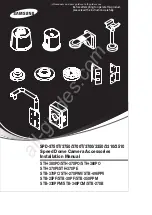
Page 15
Pre-Operation Notes and Details
Operation
Ramp Safety
Wheelchair passengers and attendants (when
applicable), must use basic common sense and
good judgement regarding ramp safety. The Braun
Corporation recognizes that each wheelchair
passenger has a unique set of physical abilities
combined with the physical characteristics of his or
her wheelchair that dictate the method in which he
or she will enter and exit their Entervan. Conse-
quently, the procedures for safe operation outlined
in this manual are general in nature.
Follow all safety instructions regarding torso re-
straints, stability, balance, weight distribution and
use of attendants as specified in the owner's manual
supplied with
your
wheelchair. Determine, establish
and practice ramp boarding and exiting procedures
under the direction of your health care professional,
your wheelchair representative, and your Entervan
sales representative (dealer) to
ensure your ability
to do so safely
.
Never board an Entervan ramp if you or your
attendant are intoxicated. The wheelchair must be
positioned in the center of the ramp at all times.
You must be able to clearly view the ramp whenever
boarding and and exiting the vehicle.
It is the responsibility of the wheelchair operator
to enter and exit the Entervan on the ramp in the
safest manner.
Stabilizing Wheelchairs
Powered and manual wheelchairs are designed to
remain upright and stable during normal operation.
All activities which involve movement in a wheel-
chair have an effect on the combined center of
gravity of the occupant and wheelchair. Be aware
of the Entervan ramp slope (angle). The slope of
the ramp has a direct effect on the center of gravity.
Keep in mind your center of gravity and your ability
to maintain stability and balance.
Do not operate your wheelchair on the Entervan
ramp without assistance if your are unable to
WARNING
Be aware of
ramp slope.
52217
maintain stability and balance.
Counterbalance devices (anti-
tippers) may be available from
your wheelchair representative
to enhance stability and
balance.
Do not tilt your wheelchair
without assistance. Operate
the wheelchair at a slow and
constant speed when on the
WARNING
Position and secure
(buckle, engage,
fasten, etc.) the
wheelchair-equipped
occupant seat belt
before loading onto
the wheelchair ramp.
Failure to do so may
result in serious
bodily injury and/or
property damage.
Different types of disabilities require different types
of wheelchairs and different types of wheelchair-
equipped occupant restraint belt systems (torso
restraint). It is the responsibility of the wheelchair
passenger to have his or her wheelchair equipped
with an occupant restraint (seat belt) under the
direction of their health care professional.
Wheelchair attendants should be instructed on any
special needs and/or procedures required for safe
transport of wheelchair passengers.
The Braun Corpora-
tion recommends
wheelchair passen-
gers position and
buckle their wheel-
chair-equipped seat
belt (torso restraint),
as specified by the
manufacturer,
before
loading onto a
wheelchair ramp.
Wheelchair-Equipped Occupant Seat Belts
Содержание EntervanII
Страница 45: ...Page 43 Notes Troubleshooting...
















































